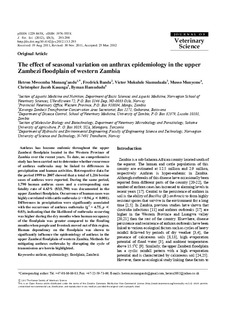| dc.contributor.author | Munang'andu, Hetron Mweemba | |
| dc.contributor.author | Banda, Fredrick | |
| dc.contributor.author | Siamudaala, Victor | |
| dc.contributor.author | Munyeme, Musso | |
| dc.contributor.author | Kasanga, Christopher Jacob | |
| dc.contributor.author | Hamududu, Byman | |
| dc.date.accessioned | 2019-10-16T15:56:11Z | |
| dc.date.available | 2019-10-16T15:56:11Z | |
| dc.date.created | 2012-11-26T10:58:45Z | |
| dc.date.issued | 2012 | |
| dc.identifier.citation | Journal of Veterinary Science. 2012, 13 (3), 293-298. | nb_NO |
| dc.identifier.issn | 1229-845X | |
| dc.identifier.uri | http://hdl.handle.net/11250/2622661 | |
| dc.description.abstract | Anthrax has become endemic throughout the upper Zambezi floodplain located in the Western Province of Zambia over the recent years. To date, no comprehensive study has been carried out to determine whether recurrence of anthrax outbreaks may be linked to differences in precipitation and human activities. Retrospective data for the period 1999 to 2007 showed that a total of 1,216 bovine cases of anthrax were reported. During the same period, 1,790 human anthrax cases and a corresponding case fatality rate of 4.63% (83/1,790) was documented in the upper Zambezi floodplain. Occurrence of human cases was highly correlated with cattle outbreaks (r = 0.94, p < 0.001). Differences in precipitation were significantly associated with the occurrence of anthrax outbreaks (χ2 = 4.75, p < 0.03), indicating that the likelihood of outbreaks occurring was higher during the dry months when human occupancy of the floodplain was greater compared to the flooding months when people and livestock moved out of this region. Human dependency on the floodplain was shown to significantly influence the epidemiology of anthrax in the upper Zambezi floodplain of western Zambia. Methods for mitigating anthrax outbreaks by disrupting the cycle of transmission are herein highlighted. | nb_NO |
| dc.language.iso | eng | nb_NO |
| dc.publisher | Korean Society of Veterinary Science | nb_NO |
| dc.rights | Navngivelse-Ikkekommersiell 4.0 Internasjonal | * |
| dc.rights.uri | http://creativecommons.org/licenses/by-nc/4.0/deed.no | * |
| dc.title | The effect of seasonal variation on anthrax epidemiology in the upper Zambezi floodplain of western Zambia | nb_NO |
| dc.type | Journal article | nb_NO |
| dc.type | Peer reviewed | nb_NO |
| dc.description.version | publishedVersion | nb_NO |
| dc.source.pagenumber | 293-298 | nb_NO |
| dc.source.volume | 13 | nb_NO |
| dc.source.journal | Journal of Veterinary Science | nb_NO |
| dc.source.issue | 3 | nb_NO |
| dc.identifier.doi | 10.4142/jvs.2012.13.3.293 | |
| dc.identifier.cristin | 964872 | |
| dc.description.localcode | ⓒ 2012 The Korean Society of Veterinary Science. This is an Open Access article distributed under the terms of the Creative Commons Attribution Non-Commercial License (http://creativecommons.org/licenses/by-nc/3.0) which permits unrestricted non-commercial use, distribution, and reproduction in any medium, provided the original work is properly cited. | nb_NO |
| cristin.unitcode | 194,64,91,0 | |
| cristin.unitname | Institutt for bygg- og miljøteknikk | |
| cristin.ispublished | true | |
| cristin.fulltext | original | |
| cristin.qualitycode | 1 | |

